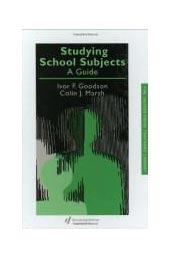Studying School Subjects: a guide
Conclusions, Complexities and Conjectures
The establishment of 'discipline' status inside the universities which had been so systematically pursued since MacKinder's 1903 proclamation provided a range of material improvements
in the subject's place within schools. In 1954 Honeybone could claim that 'at long last, geography is forcing its complete acceptance as a major discipline in universities, and that geographers are welcomed in to commerce, industry and the professions, because they are well educated men and women.' Acceptance as a major vocational qualification finally meant that geography could claim its place in educating the most able children, and thereby become established as a well-funded department inside schools staffed with trained specialists on graded posts. By 1967 Marchant noted that geography was 'at last attaining to intellectual respectability in the academic streams of our secondary schools'. But he noted that the battle was not quite over and gave the instances where the subject was still undesirably taught as a 'less able' option. With the launching of new geography the subject finally attained total acceptance as an academic discipline in universities and as a fully-fledged 'A' level subject in all schools, with the resources and 'costly provisions' which such status attracts.
In biology the evolution of the subject is distinguishable from geography because from the beginning there was an associated and well-established university base in the form of botany and zoology. For this reason and also because from the outset the subject benefited from the side-effects of the influential science lobby the task of subject promotion never totally resembled geography's 'beginning from scratch'. Biology's task was more to present a case for inclusion within the, by then well-established (and consequently well-resourced) science area of the curriculum. This task was often pursued within the overall arena of the Science Masters Association, who from the 1930s on wards played an active role in promoting biology. In 1936 an influential biology sub-committee was formed to promote biology syllabuses, and many articles in the Association's 'School Science Review' argued the case for biology's recognition as an examination subject for the able student. The problem was best voiced by the Ministry of Education in 1960: 'The place which is occupied by advanced biological studies in schools…is unfortunately that of vocational training rather than of an instrument of education.' The need to be seen as an 'instrument of education' meant that the promoters of the subject needed to move away from the utilitarian towards more academic versions - only then could an 'A' level subject command sufficient pupil numbers to warrant 'departmental' status and resources in schools. Hence we find the common theme being advocated: biology must be treated 'as a comprehensive discipline in its own right'.
In the final stages in the promotion of biology as an 'academic discipline', the two main initiatives stressed the subject as a hard science needing 'laboratories and equipment'. In the rapidly expanding universities it was this version of the subject which was widely introduced, thereby establishing the academic discipline base; likewise the Nuffield Biology Project for Schools centred on 'a crusade in terms of equipment and laboratory staff'. With the new generation of biology graduates trained in this hard science at universities, the establishment of the subject as a fully fledged academic '0' and 'A' level subject was finally assured.
